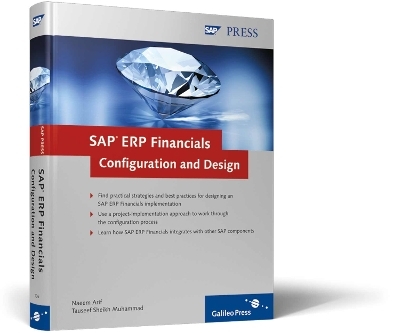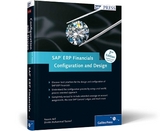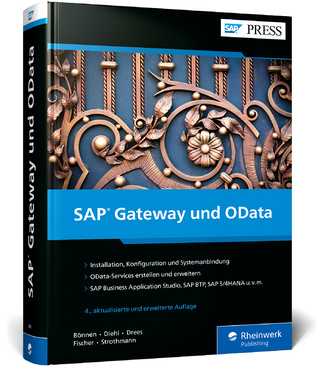
SAP ERP Financials: Configuration and Design
SAP Press (Verlag)
978-1-59229-136-6 (ISBN)
- Titel ist leider vergriffen;
keine Neuauflage - Artikel merken
This invaluable guide is the one resource you need to understand the configuration and design process, the enterprise structure, reporting, data migration, Accounts Payable and Receivable, integration with other components, and all other critical areas of SAP ERP Financials. SAP ERP Financials: Configuration and Design is a must-have tool for all implementation teams, project managers, and consultants working on an SAP ERP Financials upgrade or new implementation.
Naeem is an experienced SAP Consultant, having started his SAP career in 1995 on version 3.0h. He has been involved in more than 12 successful projects across the full ERP Financials module, working for some of the largest SAP Consultancies in the world. During this time he has worked on projects spanning many different industry sectors across Europe and the North America. Most recently he delivered an ECC 6.0, New General Ledger Solution for a major international corporation. Tauseef is an experienced SAP consultant, having delivered many projects in ERP Financials across North America, Europe and Pakistan. His experience has been across the full-project life cycle and he recently completed successful delivery of his 10th project. Tauseef has also delivered two full FICO Academies, with a combined passing percentage of 80%. During his career, Tauseef (who is also a Chartered Accountant) has worked for global consultancies and brings an International perspective to the book.
Acknowledgments ... 15
1 Overview ... 17
... 1.1 Introduction ... 17
... 1.2 Brief history of SAP ... 20
... 1.3 SAP Implementation Overview ... 21
... 1.4 SAP Navigation Basics ... 25
... 1.5 Summary ... 31
2 SAP Enterprise Structure ... 33
... 2.1 Building an Enterprise Structure ... 34
... 2.2 Building a Straw Man ... 35
... 2.3 Straw Man Design ... 39
... 2.4 Configuration of Enterprise Structure ... 41
... 2.5 Summary ... 65
3 Financial Accounting Component (FI) Global Settings ... 67
... 3.1 What Is a Document in SAP? ... 68
... 3.2 Configuration of Global Settings ... 71
... 3.3 Sales and Purchase Tax ... 109
... 3.4 Summary ... 119
4 New General Ledger ... 121
... 4.1 Overview of the GL ... 122
... 4.2 Building Your New GL Blueprint ... 127
... 4.3 Configuration Steps to Activate the New GL ... 129
... 4.4 Summary ... 162
5 Accounts Payable ... 163
... 5.1 Overview of the P2P cycle ... 164
... 5.2 Building an AP Business Model ... 167
... 5.3 Master Data ... 168
... 5.4 Vendor Account Groups ... 171
... 5.5 Vendor Number Ranges ... 180
... 5.6 Accounting Clerks ... 185
... 5.7 Define Sensitive Fields for Dual Control ... 186
... 5.8 House Banks ... 188
... 5.9 Invoice Processing ... 193
... 5.10 Document Parking ... 197
... 5.11 Outgoing Payments Processing ... 198
... 5.12 Summary ... 213
6 Accounts Receivable ... 215
... 6.1 Overview of the Order-to-Cash Process ... 215
... 6.2 Building an Accounts Receivable Business Model ... 218
... 6.3 Master Data ... 219
... 6.4 Customer Master Records ... 219
... 6.5 Finance Documents Global Settings ... 236
... 6.6 Customer Invoice Processing ... 237
... 6.7 Customer Payments ... 239
... 6.8 Debtor Management ... 246
... 6.9 Summary ... 264
7 Asset Accounting ... 265
... 7.1 Overview of Asset Accounting ... 266
... 7.2 Building Blocks of Asset Accounting ... 267
... 7.3 Building an Asset Accounting Business Model ... 272
... 7.4 Asset Accounting Configuration ... 273
... 7.5 Asset transaction processing ... 304
... 7.6 Summary ... 320
8 Controlling Component (CO) in SAP ERP ... 323
... 8.1 Overview and Diagram ... 324
... 8.2 Subcomponents of the Controlling Component (CO) ... 325
... 8.3 Building a Controlling Model ... 327
... 8.4 Configuration Settings in the Controlling Component (CO) ... 330
... 8.5 Summary ... 361
9 ERP Financials Integration ... 363
... 9.1 Automatic Account Determination ... 365
... 9.2 Master Data ... 382
... 9.3 Interfaces ... 390
... 9.4 The Value of Integration Testing ... 396
... 9.5 Summary ... 396
10 Data Migration ... 397
... 10.1 Key Principles of Data Migration ... 398
... 10.2 The Six-Step Migration Model ... 399
... 10.3 Inventory Transfer ... 404
... 10.4 Open Items Transfer ... 405
... 10.5 Upgrade to SAP ERP ECC 6.0 ... 406
... 10.6 Asset Accounting Legacy Data Transfer ... 407
... 10.7 Summary ... 413
11 Period-End Closing ... 415
... 11.1 Fast Close with the New GL ... 416
... 11.2 Key Elements of a Period End Timetable ... 417
... 11.3 Dependent Activities Already Completed ... 417
... 11.4 Analysis of Period-End Activities ... 417
... 11.5 Summary ... 424
12 SAP ERP Financials Reporting ... 425
... 12.1 Building Your Reporting Suite ... 425
... 12.2 Reporting Tools ... 427
... 12.3 Common Reporting Requirements ... 429
... 12.4 Creating Basic Management Accounting Reports with Report Painter ... 435
... 12.5 Summary ... 455
| Erscheint lt. Verlag | 30.1.2010 |
|---|---|
| Reihe/Serie | SAP Press |
| Verlagsort | Maryland |
| Sprache | englisch |
| Einbandart | gebunden |
| Themenwelt | Mathematik / Informatik ► Informatik ► Netzwerke |
| Informatik ► Weitere Themen ► SAP | |
| ISBN-10 | 1-59229-136-8 / 1592291368 |
| ISBN-13 | 978-1-59229-136-6 / 9781592291366 |
| Zustand | Neuware |
| Informationen gemäß Produktsicherheitsverordnung (GPSR) | |
| Haben Sie eine Frage zum Produkt? |
aus dem Bereich



